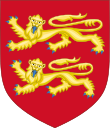House of Normandy
| House of Normandy | |
|---|---|
 Arms of the duchy of Normandy[nb 1] | |
| Country | France, England |
| Founded | 911 |
| Founder | Rollo |
| Final ruler | Henry I of England |
| Titles |
|
| Estate(s) | Normandy, England, Flanders |
| Deposition | 1135 |
| Cadet branches | Illegitimate lines:
|
| |
The House of Normandy is the usual designation for the family that were the Counts of Rouen, Dukes of Normandy and Kings of England which immediately followed the Norman conquest of England and lasted until the House of Plantagenet came to power in 1154. It included the Viking Rollo and his descendants, and William the Conqueror and his heirs down through 1135. After that it was disputed between William's grandchildren, Matilda, whose husband Geoffrey was the founder of the Angevin Dynasty, and Stephen of the House of Blois (or Blesevin dynasty).
The Norman counts of Rouen were:
Rollo, 911–927
William Longsword, 927–942
The Norman dukes of Normandy were:
Richard I, 942–996
Richard II, 996–1027
Richard III, 1026–1027
Robert I, 1027–1035
William, 1035–1066 (became King of England as William the Conqueror)
The Norman monarchs of England and Normandy were:
William the Conqueror, 1066–1087
William II, 1087–1100 (not Duke of Normandy)
Robert II, 1087–1106 (not King of England)
Henry I, 1100–1135; 1106–1135
William Adelin, 1120 (not King of England)
Matilda, 1135–1153[1]
Stephen (non-agnatic; a member of the House of Blois), 1135–1154
Norman Count of Flanders:
William Clito (r. 1127–1128), son of Robert Curthose, great-grandson of Baldwin V, designated by Louis VI of France
Family tree
Counts of Rouen and Dukes of Normandy shown in bold.
Rollo Count of Rouen 911–927 | |||||||||||||||||||||||||||||
William ‘Longsword’ Count of Rouen 927–942 | |||||||||||||||||||||||||||||
Richard I ‘the Fearless’ Duke of Normandy 942–996 | |||||||||||||||||||||||||||||
Richard II ‘the Good’ Duke of Normandy 996–1027 | |||||||||||||||||||||||||||||
Richard III Duke of Normandy 1026-1027 | Robert I ‘the Magnificent’ Duke of Normandy 1027–35 | ||||||||||||||||||||||||||||
William II (King William I) ‘the Conqueror’ Duke of Normandy 1035–87 King of England 1066–87 | |||||||||||||||||||||||||||||
Robert II ‘Curthose’ Duke of Normandy 1087–1106 | William II ‘Rufus’ King of England 1087–1100 Ducal Regent 1096–1100 | Henry I ‘Beauclerc’ King of England 1100–35 Duke of Normandy 1106–35 | Adela m. Stephen II, Count of Blois | ||||||||||||||||||||||||||
William Clito Count of Flanders Ducal claimant | Stephen King of England 1135–54 Duke of Normandy 1135–44 | ||||||||||||||||||||||||||||
Geoffrey, Count of Anjou Duke of Normandy 1144–50 | Matilda I Lady of the English | William III Adelin Duke of Normandy 1120 in his father's lifetime | |||||||||||||||||||||||||||
Henry II Duke of Normandy 1150–89 King of England 1154–89 | |||||||||||||||||||||||||||||
Henry ‘the Young King’ Duke of Normandy 1170–83 in his father's lifetime | Richard IV (King Richard I) ‘Lionheart’ Duke of Normandy & King of England 1189–99 | John ‘Lackland’ Duke of Normandy & King of England 1199–1216 | |||||||||||||||||||||||||||
Henry III Duke of Normandy 1216–59 (renounced at Treaty of Paris) King of England 1216–72 | |||||||||||||||||||||||||||||
References and notes
^ Matilda's inheritance was usurped by her cousin Stephen of England in 1135. She recovered Normandy, but ruled in England only in 1141 as Lady of the English. However, Matilda maintained her dynastic rights until she abdicated them in favour of her son Henry II of England in 1153 following the Treaty of Wallingford.
See also
*Royal House* House of Normandy | ||
New title | Ruling House of the Duchy of Normandy 911 – 1154 | Succeeded by House of Plantagenet |
| Preceded by House of Wessex | Ruling House of the Kingdom of England 1066 – 1154 | |
| Preceded by House of Estridsen | Ruling House of the County of Flanders 1127 – 1128 | Succeeded by House of Alsace |
New title | Ruling House of the County of Eu 996 – 1246 | Succeeded by House of Lusignan |
This Normandy-related article is a stub. You can help Wikipedia by expanding it. |
This article related to British royalty is a stub. You can help Wikipedia by expanding it. |